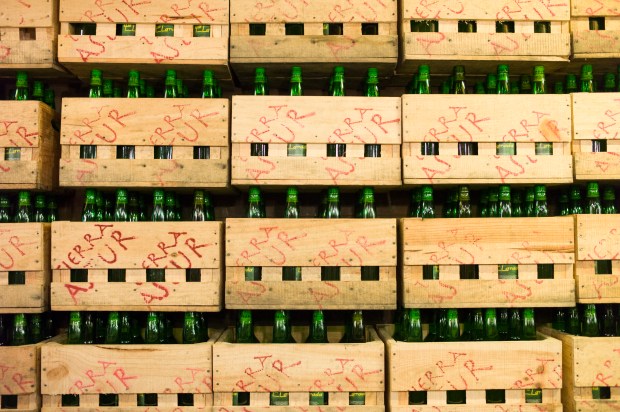If there’s one drink that defines Asturias, it’s cider. There is no city or town in Asturias where fermented apple juice served in a traditional green bottle is not an integral part of daily life. Though it is drunk year-round, it’s especially popular in the spring and summer, when the sun starts to clear through the Asturias clouds.
First, the pour: The bottle is held high above the glass, and the liquid splatters a bit as it hits the edge of your cup. The motion provides aeration, bringing out the cider’s rich flavors. Drink your glass in one swift gulp, preferably while standing, and toss what remains on the floor (that’s why the floors of so many cider houses are covered in sawdust).
The tiny town of Villaviciosa is said to be the birthplace of cider, and it is there, along with neighboring Nava, Siero, and Gijón, that most of the province’s cider is produced. Cider tourism is on the rise, and traditional cider houses, like Casa Cortina in Villaviciosa, are increasingly offering tours of their distilleries, sometimes along with traditional Asturian food.
A great way to try Asturian ciders is to go with the award winners: Cortina, Castañón, and Viuda de Angelón are all sure bets. But it’s also not uncommon to find small-batch artisanal bottles of the stuff—don’t pass up an opportunity to try homemade cider if it’s offered to you.
Some say that cider loses its original flavor once it crosses the Cantabrian Mountains, which cuts Asturias off from the rest of Spain. But if you want to take a few bottles home with you, La Gijonesa, in Gijón, carries a range of Asturian ciders in addition to foods, like local cheeses, jams, and cured meats, as well as Asturcilla, an Asturian version of Nutella.

Every city in Asturias has its own zona de sidrerías or cider district. Gascona Street is Oviedo’s, and every May these bars and restaurants offer free or discounted tastes of the drink. Visit La Finca, a cider house and “agrobar” that serves traditional Asturian dishes, like fabada asturiana (bean soup), with a contemporary twist.
In Gijón, the place to visit is Cimadevilla, a fishing neighborhood by the port. There are several cider houses surrounding Lavaderu Plaza, in the heart of the neighborhood, including La Tabacalera, which has a perfect menu for sharing with friends.
But the love of cider goes beyond cider houses. Asturians love to drink in the street, and it’s not uncommon to see locals young and old carrying cases of bottles for a leisurely afternoon outdoor drinking session. It’s especially common during one of our many festivals, like El Carmín de la Pola de Siero, in late July, which celebrates the patron saint of Carmín de la Pola, a town 15 miles south of Gijón.
Though widespread, it’s technically illegal to drink in the street. However, there are a few exceptions: In Gijón, there’s La Cuesta del Cholo, a tiny cobblestone street in the old downtown, where you can down a few bottles and watch the sun set over the sea. You’ll be able to tell the locals from the tourists by the way they pour. If you’re new to the practice, you might end up with most of your cider on your shoes—but it’s all part of the charm.